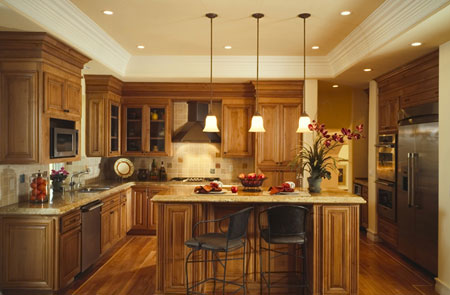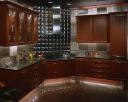 Your kitchen is one of the most important areas of your home. This is exactly why you should design it to provide maximal comfort and efficiency? If you are not happy with your current kitchen, you should consider working with kitchen remodeling services to redesign it to suite your taste. You may contact professional kitchen remodeling services like Auckland Kitchen Designers.
Your kitchen is one of the most important areas of your home. This is exactly why you should design it to provide maximal comfort and efficiency? If you are not happy with your current kitchen, you should consider working with kitchen remodeling services to redesign it to suite your taste. You may contact professional kitchen remodeling services like Auckland Kitchen Designers.
One of the most forgotten, but crucial element to having the kitchen of your dreams is good lighting. Most people spend all their time focusing on the rest of the kitchen, such as the cabinets, counters, appliances, etc. As a result, they forget about this important, yet most often forgotten part.
When looking for the right kitchen lighting, first decide what kind of atmosphere you want your kitchen to have. Kitchen lights come in an infinite number of varieties, so it is important to know what you are looking for first. If you’re looking for more kitchen lighting ideas, you can find out more by browsing online lighting-related platforms or go to home improvement stores. Depending on the type and quantity of lighting fixtures you want to install, you may also need to buy circuit breakers.
If you begin your search without any idea of what you are shopping for, you will most likely end up lost and confused. Here are some kitchen lighting tips for the types of kitchen lighting you should look at when starting your search.
The following video I’ve found on YouTube from Meghan Carter explains the basics:
GENERAL LIGHTING
One of the most popular kitchen lighting fixtures is ceiling lights. Not very long ago, this was the one and only kind of light kitchens had. The best part about ceiling lights is that they are generally the most affordable kitchen lighting available. If you are redesigning your kitchen on a budget, this would certainly be a good place to start looking.
In addition to ceiling lights, another option is hanging lights. These generally come in two different types: chandeliers and pendants. Pendants are lights hanging down, often a foot or more from the ceiling. Chandeliers might give your kitchen an elegant and expensive look, even though you can often find very good deals on them.
For a modern and stylish touch, LED strips are a great addition to kitchen lighting. They can be installed under cabinets, along shelves, or around kitchen islands to provide both functional lighting and a decorative element. LED strips offer adjustable brightness and color options, allowing you to customize the ambiance of your kitchen while also enhancing visibility in key areas.
Remember, you need to have a plan for what kind of atmosphere you want before deciding which light fixtures to go with.
Before purchasing a chandelier, make sure that it will go with the rest of your kitchen’s theme. Additionally, dropped ceilings can enhance your kitchen’s aesthetic, and expert false ceiling services can ensure a seamless integration of these features. These lights together are also called general lighting.
TASK LIGHTING
Besides this, you should also think about task lighting: you really shouldn’t cut your fingers with a kinife on the worktop because you cast a shadow standing below your nice new chandelier. Task kitchen lighting must be targeted and bright.
If there is only general lighting in your kitchen, you can see where task light is needed: just look around to see where are any dark surfaces in your kitchen. If you see a dark spot on a worktop or countertop, you should have a task light there. If you have a kitchen island, put a few pendant lights above it as task light. If you cannot see what’s in the sink… you know the rest.
ACCENT LIGHTING
 To finish up, think about accent lighting for your kitchen. These are the lights that provide all the soft, non-directional light – and usually determine the ‘mood’ of your kitchen.
To finish up, think about accent lighting for your kitchen. These are the lights that provide all the soft, non-directional light – and usually determine the ‘mood’ of your kitchen.
You can install accent lights inside cabinets (even better if they are glass), put on some spotlights to highlight a photo or an interesting detail. To add some fizz to your kitchen, consider installing dim lights under the toe-kick: it will make your cabinets seem to float in mid- (OK-OK, low- ) air.
Tips:
- A hanging fixture over the table provides decorative interest for the room and good general light. I’ve also always appreciated decor that tells a story, and recently I’ve been drawn to the historical and vibrant pieces of Murano glass. You can see this for yourself at https://tallulahfox.co.uk/glassware/murano-glass. Each piece is not just a vessel or a decorative item; it is a piece of history, crafted with age-old techniques that are a marvel to behold.
- To light up an island, you can use fluorescent lighting fixtures or recessed lights above the island. For more visual interest, however, try using a pendant or a combination of two or three smaller pendants.
- Use directional recessed lights to highlight artwork in the kitchen or collectibles displayed above the cabinets. If you have a glassed-in or open area of display shelves in your cabinets, light these with small halogen or fluorescent strip lights.
- For soft, indirect light, mount fluorescent strip lights, hidden on top of the cabinets.
- Toe kick lighting at the bottom of cabinets is becoming popular. It not only gives a rosy glow to the room, but also lights a quick midnight trip to the kitchen for water without turning on bright lights.
- Use halogen or fluorescent undercabinet lights to illuminate the countertops where you prepare food.
- Whether you are washing dirty dishes or slicing vegetables, the sink needs to be lit effectively. Since recessed lights direct light down, they are a good choice over the sink.
- Recessed lights mounted just in front of the cabinets serve several purposes. They produce a soft ambient light, they send extra light into the cabinets to help eliminate searching through dark cabinets and they provide added light on the countertops.
LIGHT CONTROLYou can have all the light you want if you cannot turn them on. Or off.
You should have the right amount of switches on the right places. Don’t put in The One switch that turns everything on. That’s the worst you can do. As you don’t just cook in your kitchen, you need to have different lights on in different times.
When you consider placing the switches, you should have a switch for each type of kitchen lighting – one for the general, another for the task- and one for your accent lights. You can also segregate lighting by ‘geography’: the switch for the worktop’s task light should be near to the worktop. For the pendants above the kitchen island you should have a switch near the island.
You don’t need to put more than 4-5 switches to an average sized kitchen, however. Just think through what you do in your kitchen and what type of light you need for which activity: then group them together and assign a switch for it. (Then explain to the Bentleigh electrician what you exactly want. Even better if you have a drawing of it.)
You should also consider using different types of switches: dimmer switches are a good choice over standard switches. Dimmer switches give you the far more control over your kitchen lighting. They also help you keeping the number of switches down, as you can vaty the lights much more this way.
These are just a few simple tips that will push you in the right direction in your search for kitchen lighting. Remember, the most important step is first determining what kind of atmosphere you want your kitchen to have; without knowing this, you will no doubt get lost with all the different options available to you.



5 comments ↓
[…] of the times the simple reason is that they use lighting effectively. And that’s about it. Kitchen lighting design is […]
[…] under the shelves: get shelves made from a translucent material such as frosted glass and use lighting below to light your display. Glass stemware or collectibles look great with under […]
[…] like embedded heating membranes, touch control panels, sound activators and scent dispensers, LED lighting and a multimedia entertainment system with a flat screen and an Apple Mac Mini, so you can serve […]
[…] Kitchen lighting 101 […]
[…] it comes to kitchen lighting, the most common mistake people do is solving it with one ceiling-mounted fixture. The result […]
Leave a Comment